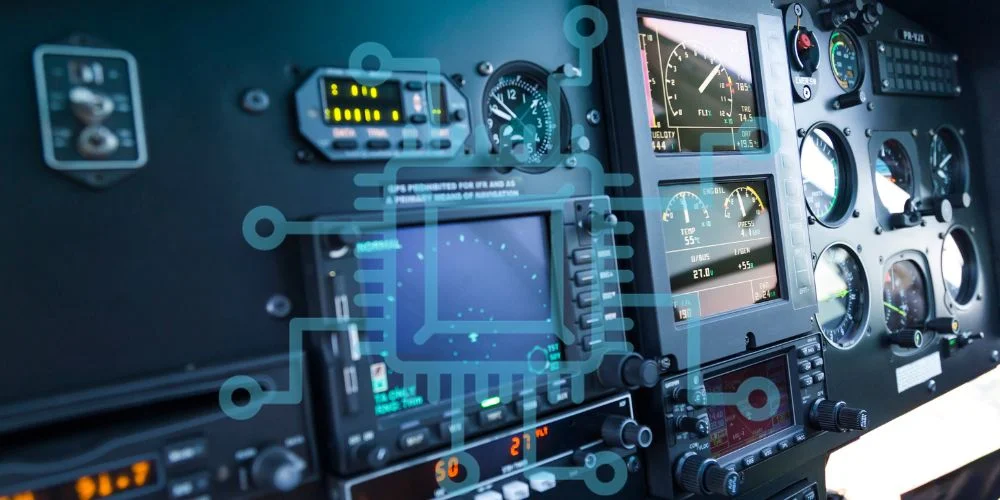Technology is soaring to new heights in aviation, and at the forefront of this transformation lies embedded avionics systems. Seamlessly integrating advanced electronics and aviation engineering, these systems propel aircraft to unprecedented safety, efficiency, and performance levels. In this article, we delve into the world of embedded avionics systems, exploring their significance, challenges, and the remarkable impact they hold in shaping the future of aviation.
Merging Technology and Flight
Embedded avionics systems stand as a testament to the fusion of electronics and aerospace engineering, resulting in aircraft that are not just vessels of transportation but also intelligent and highly capable platforms. These systems encompass various applications, from flight control and navigation to communication and passenger entertainment. It empowers pilots to navigate, communicate, and operate aircraft with unprecedented precision by integrating sensors, processors, displays, and software.
Consider the example of a modern cockpit display system. Utilizing advanced embedded avionics technology, these displays provide pilots with real-time data on flight parameters, navigation routes, weather conditions, and more. Integrating electronics and aviation engineering enhances situational awareness, enabling pilots to make informed decisions that contribute to flight safety.
Elevating Flight Experience
The impact of embedded avionics systems extends far beyond the realm of engineering—it directly affects passengers’ flight experiences and the overall safety of air travel. These systems enrich the flying experience by providing real-time information, entertainment options, and seamless connectivity. Air travel is a technological marvel, from in-flight entertainment systems to advanced weather tracking.
Consider the integration of Passenger Information Systems (PIS) in aircraft cabins. Embedded avionics technology enables passengers to access flight information and entertainment content and connect to Wi-Fi during their journey. This technological integration transforms the passenger cabin into a dynamic and connected environment.
Overcoming the Skies’ Challenges
While embedded avionics systems hold immense promise, their development comes with unique challenges. The aviation environment is inherently complex, demanding systems that can operate reliably in diverse conditions, from high-altitude flights to extreme weather. Ensuring they are robust, fault-tolerant, and capable of handling unforeseen scenarios is critical to their design.
Moreover, safety considerations are paramount in aviation. It must adhere to stringent safety standards to ensure the protection of both passengers and crew. Developing systems that can detect and respond to anomalies, perform self-diagnostics, and even manage failure situations requires a meticulous approach and a deep understanding of aviation regulations.
Innovative Synergy
Developing embedded avionics systems thrives on collaboration among aircraft manufacturers, avionics suppliers, software developers, and safety experts. This interdisciplinary approach ensures that aircraft systems are technologically advanced but also reliable, safe, and compliant with aviation industry standards.
Consider the partnership between an aerospace company and a technology firm to design an advanced Flight Management System (FMS). The team can create an FMS that optimizes flight routes, fuel consumption, and overall flight efficiency by integrating embedded avionics technology, navigation algorithms, and real-time data processing capabilities.
A Vision for the Skies
As we peer into the future, the vision for embedded avionics systems becomes even more promising. The growth of electric and hybrid aircraft, the advancement of autonomous flight, and the integration of Artificial Intelligence (AI) will drive embedded avionics systems to be even more sophisticated, adaptive, and capable of handling complex aerial operations.
Imagine a world where autonomous cargo drones use embedded avionics systems to navigate urban skies, delivering packages with efficiency and precision. Envision a future where electric passenger aircraft leverage embedded technology to optimize energy consumption, reduce emissions, and redefine the concept of sustainable air travel. These possibilities become attainable as embedded avionics systems continue to evolve and redefine aviation technology.
Conclusion
Embedded avionics systems are not just about technology—they’re about pioneering a new era of aviation that merges innovation with safety, efficiency, and connectivity. By integrating electronics into aircraft, we are reshaping how we experience flight, interact with onboard systems, and ensure air travel safety.
In an industry where safety and precision are paramount, the significance of embedded avionics systems cannot be overstated. Engineers and researchers can harness the potential of embedded avionics systems to create transformative solutions that revolutionize aviation through collaboration, adherence to aviation standards, and a commitment to continuous improvement. As we continue to explore the dynamic landscape of aviation technology, let us recognize that embedded avionics systems are not just elevating flight—they’re propelling us toward a future of smarter, safer, and more connected skies.










